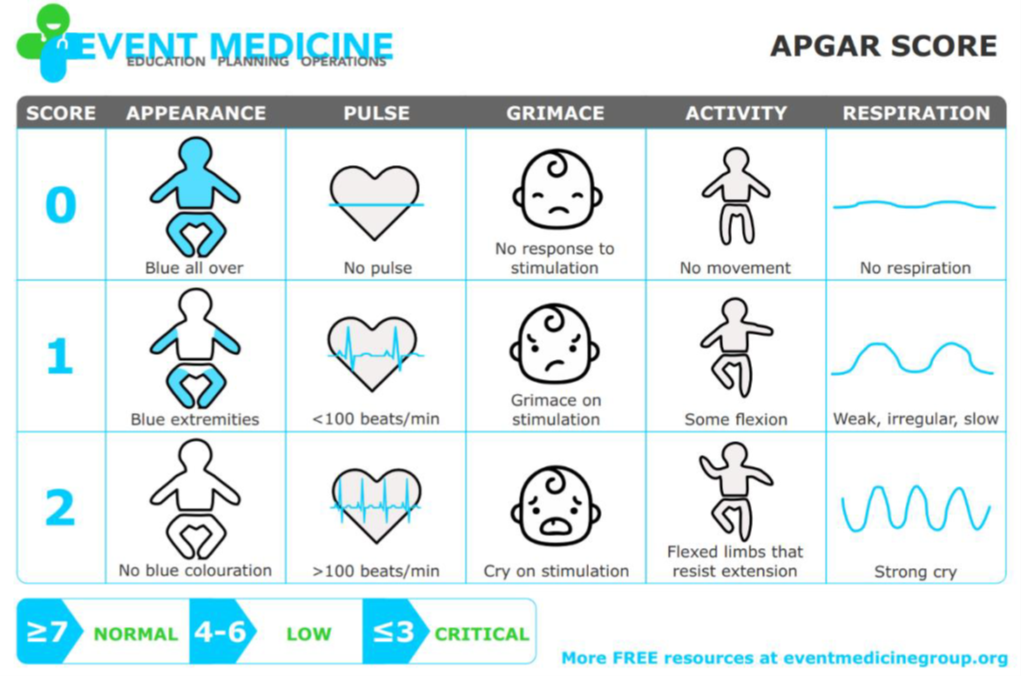Chapter 5: Prenatal Development
Newborn Assessment and Risk
Newborn Assessment and Risk
Assessing the Newborn
In the minutes following birth, a newborn must undergo dramatic systemic changes to be able to survive outside the womb. An obstetrician, midwife, or nurse can estimate how well a newborn is doing by obtaining an APGAR score. The Apgar score was introduced in 1952 by anesthesiologist Dr. Virginia Apgar as a method to assess the effects on the newborn of anesthesia given to the laboring mother. Healthcare providers now use it to assess the general wellbeing of the newborn, whether or not analgesics or anesthetics were used.
Five criteria are assessed:
- Skin color
- Heart rate
- Reflex,
- Muscle tone
- Respiration
Each criterion is assigned a score of 0, 1, or 2. Scores are taken at 1 minute after birth and again at 5 minutes after birth. Each time that scores are taken, the five scores are added together. High scores (out of a possible 10) indicate the baby has made the transition from the womb well, whereas lower scores indicate that the baby may be in distress. The technique for determining an APGAR score is quick and easy, painless for the newborn, and does not require any instruments except for a stethoscope.
Of the five APGAR criteria, heart rate and respiration are the most critical. Poor scores for either of these measurements may indicate the need for immediate medical attention to resuscitate or stabilize the newborn. In general, any score lower than 7 at the 5-minute mark indicates that medical assistance may be needed. A total score below 5 indicates an emergency situation. Normally, a newborn will get an intermediate score of 1 for some of the APGAR criteria and will progress to a 2 by the 5-minute assessment. Scores of 8 or above are normal.

Video 5.7 APGAR Score explains how to calculate the APGAR score for a newborn.
Another way to assess the condition of the newborn is by administering the Neonatal Behavioral Assessment Scale (NBAS) developed by Brazelton in the 70’s. This scale contains 28 behavioral and 18 reflex items, that assess the baby’s capabilities across different developmental areas (autonomic, motor, state, and social-interactive systems) and describes how infants integrate these areas as they adapt to their new environment. At the time it was developed in the 70’s the approach was considered innovative for recognizing that a baby is a highly developed organism, even when just newly born. Today, this tool has been used around the world to further assess the newborn, especially those with low Apgar scores, and to make comparisons of infants in different cultures (Brazelton & Nugent, 1995).
In addition to the Apgar and the Neonatal Behavioral Assessment, newborns are also routinely screened for different conditions. Within the first 24 to 48 hours after birth, babies born in hospitals undergo a simple heel stick test, where a few drops of blood are collected on a special paper card. Providers test those dried blood spots for a variety of different congenital disorders, or conditions that are present when the baby is born. In California, newborns are now screened for 80 different genetic and congenital disorders. Newborns are also screened for hearing disorders and certain serious heart problems.
Complications of the Newborn
Low Birth Weight
We have been discussing a number of teratogens associated with a low birth weight such as cocaine, tobacco, etc. A child is considered to have a low birth weight if they weigh less than 5.8 pounds (2500 grams). About 8.52 percent of babies born in the United States are of low birth weight and 1.4 percent are born very low birth weight. A low birth weight baby has difficulty maintaining adequate body temperature because it lacks the fat that would otherwise provide insulation. Such a baby is also at more risk of infection. And 67 percent of these babies are also preterm which can make them more at risk for a respiratory infection. Very low birth weight babies (2 pounds or less) have an increased risk of developing cerebral palsy. Many causes of low birth weight are preventable with proper prenatal care.
Premature Birth
A child might also have a low birth weight if they are born at less than 37 weeks gestation (which qualifies it as a preterm baby). Early birth can be triggered by anything that disrupts the pregnant parent’s system. For instance, vaginal infections or gum disease can actually lead to premature birth because such infection causes the body to release anti-inflammatory chemicals which, in turn, can trigger contractions. Smoking and the use of other teratogens can also lead to preterm birth.
Anoxia and Hypoxia
One of the leading causes of infant brain damage is lack of oxygen shortly after birth. Hypoxia occurs when the infant is deprived of an adequate amount of oxygen, leading to mild to moderate brain damage. Anoxia occurs when the infant undergoes a total lack of oxygen, which can lead to severe brain damage. This lack of oxygen is typically caused by umbilical cord problems, birth canal problems, blocked airways, and placenta abruption. Both hypoxia and anoxia can lead to cerebral palsy and a host of other medical disorders.
Check Your Understanding
A measure to determine how well a newborn is doing after birth
28 behavioral and 18 reflex items, that assess the baby’s capabilities across different developmental areas (autonomic, motor, state, and social-interactive systems) and describes how infants integrate these areas as they adapt to their new environment

